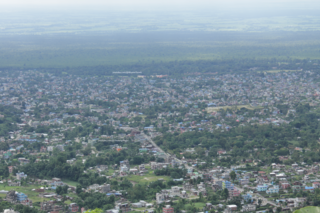
Fingerspelling is the representation of the letters of a writing system, and sometimes numeral systems, using only the hands. These manual alphabets have often been used in deaf education and have subsequently been adopted as a distinct part of a number of sign languages. There are about forty manual alphabets around the world. Historically, manual alphabets have had a number of additional applications—including use as ciphers, as mnemonics and in silent religious settings.

Miss Nepal is a national beauty pageant in Nepal. The winners are sent to Miss World, Miss Earth, Miss International.

Newar, known officially in Nepal as Nepal Bhasa, is a Sino-Tibetan language spoken by the Newar people, the indigenous inhabitants of Nepal Mandala, which consists of the Kathmandu Valley and surrounding regions in Nepal. The term "Newari" is also used to refer to the language, although it is considered to be a derogatory term by some Newar speakers.

Dharan is a sub-metropolitan city in Sunsari District of Koshi Province, in eastern Nepal, which was established as a fourth municipality in the Kingdom in 1958. It is the third most populous city in eastern Nepal after Biratnagar and Itahari. The Nepali word "dharan" means a saw pit. The rainforest from which the tree trunks came is still just on the edge of the city. Much later the British Gurkha camp opened in October 1960. The use of the camp by British Gurkhas finished in the mid-1990s. Dharan has an estimated city population of 173,096 living in 34,834 households as per the 2021 Nepal census. It is one of the cities of the Greater Birat Development Area which incorporates the cities of Biratnagar-Itahari-Gothgau-Biratchowk-Dharan primarily located on the Koshi Highway in Eastern Nepal, with an estimated total urban agglomerated population of 804,300 people living in 159,332 households. It is the largest city in the province number one by Area. It covers 192.32 square kilometers while Biratnagar and Itahari is 2nd and 3rd biggest cities by Area
Simultaneous communication, SimCom, or sign supported speech (SSS) is a technique sometimes used by deaf, hard-of-hearing or hearing sign language users in which both a spoken language and a manual variant of that language are used simultaneously. While the idea of communicating using two modes of language seems ideal in a hearing/deaf setting, in practice the two languages are rarely relayed perfectly. Often the native language of the user is the language that is strongest, while the non-native language degrades in clarity. In an educational environment this is particularly difficult for deaf children as a majority of teachers who teach the deaf are hearing. Results from surveys taken indicate that communication for students is indeed signing, and that the signing leans more toward English rather than ASL.
Japanese Sign Language, also known by the acronym JSL, is the dominant sign language in Japan and is a complete natural language, distinct from but influenced by the spoken Japanese language.
Indo-Pakistani Sign Language (IPSL) is the predominant sign language in the subcontinent of South Asia, used by at least 15 million deaf signers. As with many sign languages, it is difficult to estimate numbers with any certainty, as the Census of India does not list sign languages and most studies have focused on the north and urban areas. As of 2021, it is the most used sign language in the world, and Ethnologue ranks it as the 151st most "spoken" language in the world.
Manually coded languages (MCLs) are a family of gestural communication methods which include gestural spelling as well as constructed languages which directly interpolate the grammar and syntax of oral languages in a gestural-visual form—that is, signed versions of oral languages. Unlike the sign languages that have evolved naturally in deaf communities, these manual codes are the conscious invention of deaf and hearing educators, and as such lack the distinct spatial structures present in native deaf sign languages. MCLs mostly follow the grammar of the oral language—or, more precisely, of the written form of the oral language that they interpolate. They have been mainly used in deaf education in an effort to "represent English on the hands" and by sign language interpreters in K-12 schools, although they have had some influence on deaf sign languages where their implementation was widespread.
Śrēṣṭha is a Nepali surname, which means "most excellent” or "great” in Sanskrit. It is one of the eponym surnames used by those belonging to the caste of Shresthas who prior to the unification of modern Nepal formed the ruling and administrative castes in the court of the Malla kings of Nepal. They also counted among them the trading and business castes, and were the pre-eminent traders in between Nepal and Tibet. After the unification of Nepal, Shresthas took up business and trading since their former positions as administrators and courtiers of the royal Malla court was supplanted by the invading Gorkha forces mainly of the Khas tribe.

Durga Lal Shrestha is a Nepalese poet of Nepal Bhasa and Nepali. He was conferred with the title of Janakavi by Nepal Bhasha Parishad in 2003. He is considered as a progressive litterateur. He was awarded the Jagadamba Shree Puraskar in 2010 for "enriching Nepalese literature by writing very melodious songs, poems, poetry and children's literature in his mother tongue and Nepali language for the last six decades."
Singapore Sign Language, or SgSL, is the native sign language used by the deaf and hard of hearing in Singapore, developed over six decades since the setting up of the first school for the Deaf in 1954. Since Singapore's independence in 1965, the Singapore deaf community has had to adapt to many linguistic changes. Today, the local deaf community recognises Singapore Sign Language (SgSL) as a reflection of Singapore's diverse culture. SgSL is influenced by Shanghainese Sign Language (SSL), American Sign Language (ASL), Signing Exact English (SEE-II) and locally developed signs.

Deaf education is the education of students with any degree of hearing loss or deafness. This may involve, but does not always, individually-planned, systematically-monitored teaching methods, adaptive materials, accessible settings, and other interventions designed to help students achieve a higher level of self-sufficiency and success in the school and community than they would achieve with a typical classroom education. There are different language modalities used in educational setting where students get varied communication methods. A number of countries focus on training teachers to teach deaf students with a variety of approaches and have organizations to aid deaf students.

Namrata Shrestha is a Nepalese actress and model.
Nepalese Sign Language or Nepali Sign Language (Nepali: नेपाली साङ्केतिक भाषा, romanized: Nēpālī Sāṅkētika Bhāṣā is the main sign language of Nepal. It is a partially standardized language based informally on the variety used in Kathmandu, with some input from varieties from Pokhara and elsewhere. As an indigenous sign language, it is not related to oral Nepali. The Nepali Constitution of 2015 specifically mentions the right to have education in Sign Language for the deaf. Likewise, the newly passed Disability Rights Act of 2072 BS defined language to include "spoken and sign languages and other forms of speechless language." in practice it is recognized by the Ministry of Education and the Ministry of Women, Children and Social Welfare, and is used in all schools for the deaf. In addition, there is legislation underway in Nepal which, in line with the UN Convention on the Rights of Persons with Disabilities which Nepal has ratified, should give Nepalese Sign Language equal status with the oral languages of the country.
Signed Nepali or Sign-Supported Nepali, is a means of communication often used by (nominally) signing hearing individuals in their interactions with signing deaf, or by deaf persons who for whatever reason acquired Nepali as their mother tongue and then acquired Nepali Sign Language subsequently, or by deaf persons with people with normal hearing whose signing is judged not to be fully fluent.

Greater Nepal is an irredentist concept in Nepal, which claims current Indian and Bangladeshi territories beyond Nepal's present-day boundaries. These claims typically include the areas controlled by Nepal between 1791 and 1816, a period that ended with the Anglo-Nepalese War and the signing of Sugauli Treaty. In addition, extensive territories in the present-day Indian states of Uttar Pradesh, Bihar, West Bengal and some parts of Bangladesh are also included in the claims of the activist organisation Greater Nepal Nationalist Front, which demands the "return" of these territories to Nepal. A map similar to theirs was displayed by the mayor of Kathmandu in his office in June 2023, in reaction to an alleged "Akhand Bharat" map in the Indian Parliament building.

Nepali is an Indo-Aryan language native to the Himalayas region of South Asia. It is the official, and most widely spoken, language of Nepal, where it also serves as a lingua franca. Nepali has official status in the Indian state of Sikkim and in the Gorkhaland Territorial Administration of West Bengal. It is spoken by about a quarter of Bhutan's population. Nepali also has a significant number of speakers in the states of Arunachal Pradesh, Assam, Himachal Pradesh, Manipur, Meghalaya, Mizoram and Uttarakhand. In Myanmar it is spoken by the Burmese Gurkhas. The Nepali diaspora in the Middle East, Brunei, Australia and worldwide also use the language. Nepali is spoken by approximately 19 million native speakers and another 14 million as a second language.

Karun Thapa born on 23 March 1965) is a Nepali IT expert, film editor, 3D animator, trainer, a well-known lyricist and Ghazal writer. Karun is known for his technological contribution to Nepali IT and media industry. He has contributed by introducing Devanagari fonts in computers, introducing AVID Digital Film Editing system in Nepal and introducing 3D animation in Nepal.
The Bakery Cafe Pvt.Ltd is a restaurant chain in Nepal. The chain is recognized in Nepal as an entriprise to employ hearing impaired people as waiter and waitresses. The first cafe of the chain was established in 1991 at Teendhara, Kathmandu. The Bakery Cafe during its early days was considered to be a trend setter in the restaurant culture in Nepal.

Sumana Shrestha, is a Nepalese politician and former Minister of Education, Science and Technology. Since 2022, she has held the position of Member of the Federal Parliament in the House of Representatives of Nepal, representing the Rastriya Swatantra Party. Additionally, she is a member of the Education, Health, and Information Technology Committee of the House of Representatives. Shrestha holds the position of Central Committee member and serves as the chairperson of the Education Department and the Science, Communication, and Information Technology Department of the Rastriya Swatantra Party (RSP).










